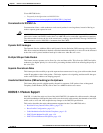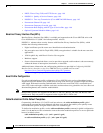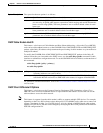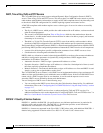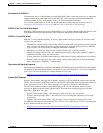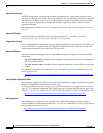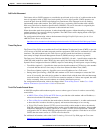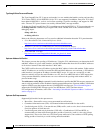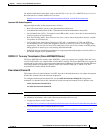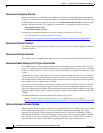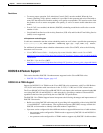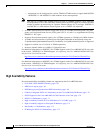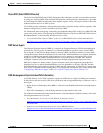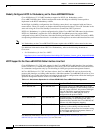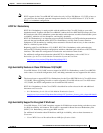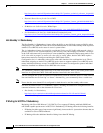
1-65
Cisco uBR7200 Series Universal Broadband Router Software Configuration Guide
OL-2239-05
Chapter1 Overview of Cisco uBR7200 Series Software
Supported Software Features for the Cisco uBR7200 Series
For detailed information about QoS, refer to the DOCSIS 1.1 for the Cisco uBR7200 Series Universal
Broadband Routers feature module on Cisco.com:
http://www.cisco.com/univercd/cc/td/doc/product/cable/cab_rout/ub7200sw/index.htm
Upstream QoS Models Supported
Supported QoS models for the upstream are as follows:
• Best effort-Data traffic sent on a non-guaranteed best-effort basis
• Committed Information Rate (CIR)—Guaranteed minimum bandwidth for data traffic
• Unsolicited Grants (UGS)—Constant bit rate (CBR) traffic, such as voice, that is characterized by
fixed size packets at fixed intervals
• Real Time Polling (rtPS)—Real Time service flows, such as video, that produce unicast, variable
size packets at fixed intervals
• Unsolicited Grants with Activity Detection (USG-AD)—Combination of UGS and RTPS, to
accommodate real time traffic that might have periods of inactivity (such as voice using silence
suppression). The service flow uses UGS fixed grants while active, but switches to RTPS polling
during periods of inactivity to avoid wasting unused bandwidth.
• Enhanced time-slot scheduling mechanisms to support guaranteed delay/jitter sensitive traffic on
the shared multiple access upstream link
DOCSIS 1.1 Two-way Transmission (Cisco uBR7246VXR Router)
The CiscouBR7200series routers allow DOCSIS 1.1 two-way transmission of digital data and Voice
over IP (VoIP) traffic over a hybrid fiber-coaxial (HFC) network. The CiscouBR7200series support IP
routing with a wide variety of protocols and combinations of Ethernet, Fast Ethernet, Gigabit Ethernet,
serial, High-Speed Serial Interface (HSSI), Packet over SONET (POS) OC-3 and OC-12c, and
Asynchronous Transfer Mode (ATM) media.
Downstream Channel ID
This feature allows all cable modems in an HFC network to identify themselves via unique downstream
channel IDs instead of their downstream frequencies.
To configure the downstream channel ID, use the cable downstream channel-id configuration
command. Use the no form of this command to set the downstream channel ID to its default value.
cable downstream channel-id id
no cable downstream channel-id
Syntax DescriptionS
For additional information, refer to the following documents on Cisco.com:
• Configuring Downstream Channel IDs
http://www.cisco.com/univercd/cc/td/doc/product/software/ios120/120newft/120t/120t4/downchan.htm
• Cisco Broadband Cable Command Reference Guide
http://www.cisco.com/univercd/cc/td/doc/product/cable/bbccmref/bbcmtscf.htm#wp1117052
id Specifies a downstream channel ID. Valid values are from 1 to 255.



